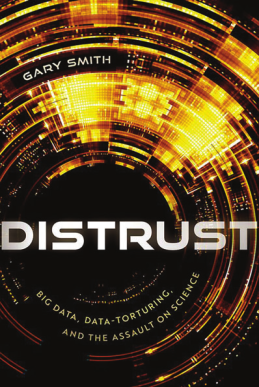PDFLINK |
New and Noteworthy Titles on our Bookshelf
August 2023

Distrust
Big Data, Data-Torturing, and the Assault on Science
By Gary Smith. Oxford University Press, 2023, 336 pp.
Reprinted with permission of Oxford Publishing Limited.
Faced with increasingly complex technology, we must consider its responsible and ethical use. The science behind this technology often boasts about how revolutionary it is. Or is it? In Distrust, Gary Smith reveals missteps that science and mathematics made when rolling out innovations such as the internet and machine learning models. Through the lenses of disinformation, data torturing, and data mining, this book leads the reader through a history of instances where the public doubts the facts.
The general lack of faith in science is a substantial and unsettling threat. Distrust is filled to the brim with examples of those who reject scientific evidence or have reasonable doubt about black-box algorithms. You will gain an appreciation from a historical perspective, as some examples date back hundreds of years. However, we cannot only blame an impressionable population for distrust in science; some scientists compound the problem when they analyze only the subset of data that corroborates the desired result or evaluate too much data and find statistical significance when events are merely coincidental.
Smith also warns against the overuse of artificial intelligence in decision-making. His examples range from medical diagnoses to image recognition where AI has overpromised and underdelivered. As it turns out, there are many ways for the public to distrust science. But what can be done? We could require researchers to publish their data and code along with results to encourage replicability. To reduce the pressure on scientists that leads to extreme data mining, we could de-emphasize statistical significance in favor of more transparent methodology. We could hold social media companies accountable for the content their users post and share. This book could be a supplement to an introductory statistics course or quantitative reasoning course.

An Introduction to the Math of Voting Methods
By Brendan W. Sullivan. 619 Wreath, 2022, 217 pp.
Created by Jean Tashima for 619 Wreath Publishing.
Most votes for elected positions in the United States allow each voter to assign a single vote to a single candidate. The votes are counted, and the winner is the candidate with the most votes. This method is straightforward, easy to implement, and voters are rarely confused. Voting theory explores other ways to determine a winner; ranked voting, for instance, allows a voter to rank all candidates in order of preference. But then one can ask: how is the winner determined? What is fair or unfair about a given system?
Sullivan’s new book could be used when teaching a unit on voting theory in a quantitative literacy or mathematics for liberal arts course. Voting often occurs outside of politics: choosing where a group will dine, who wins the Heisman trophy in college football, or which agenda items take precedence at a school board meeting. Voting theory can be understood without the prerequisites of algebra or calculus. While a more advanced student may prefer a more advanced text, the high readability of Sullivan’s book makes it compelling for all students.
The text clearly explains a variety of voting methods, including Borda count, pairwise comparisons, and approval voting. The examples are easy to follow and often illustrate surprising winners based on which method is chosen. Each section contains practice problems with solutions, along with homework exercises. The exercises require creativity; in one, students are asked to find a newspaper article about ranked choice voting and analyze the journalist’s point of view. If you find yourself wanting to convince students that understanding mathematics is important, consider this book.

